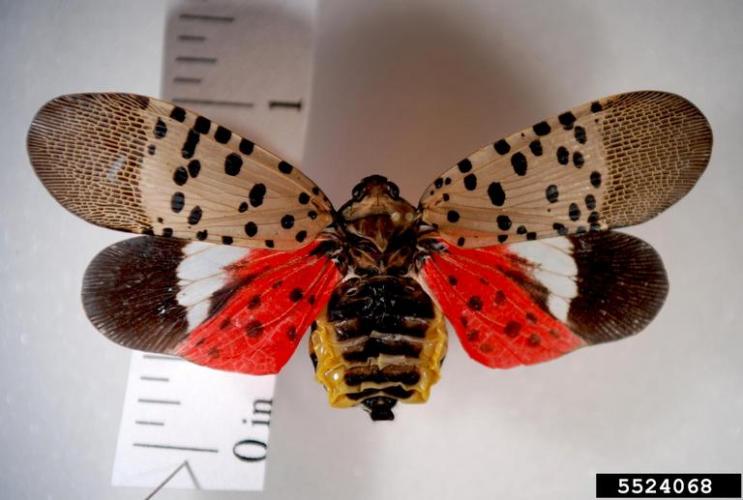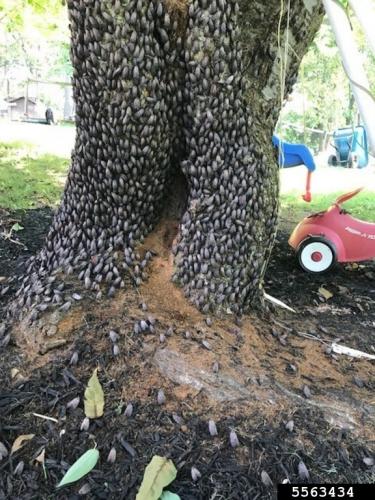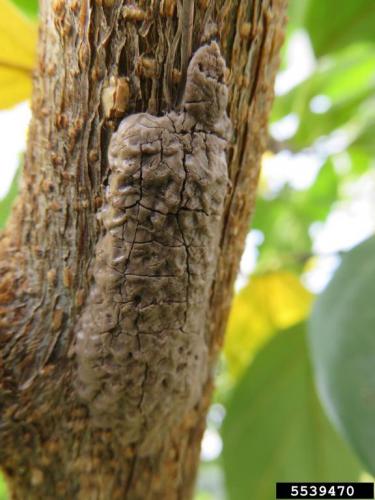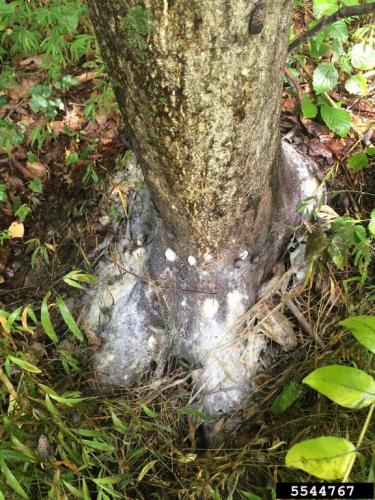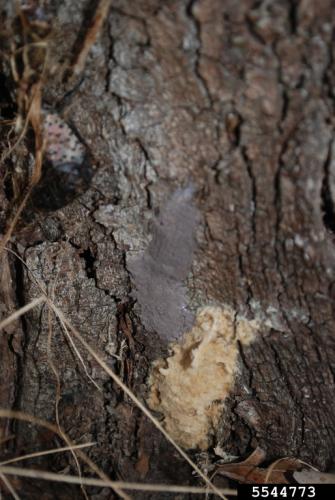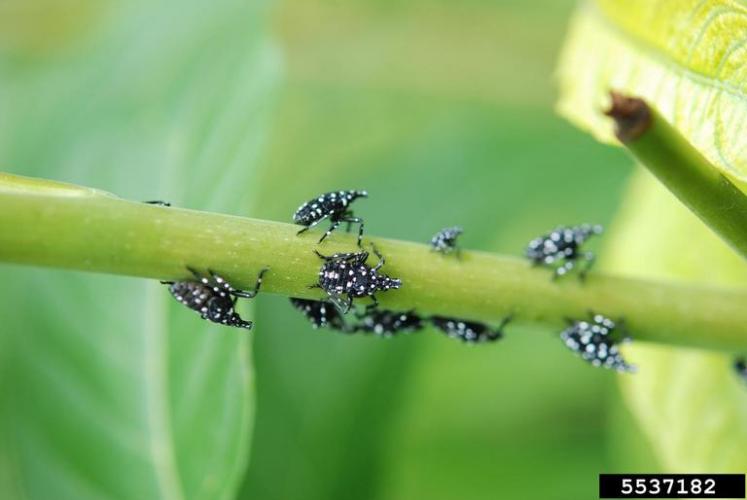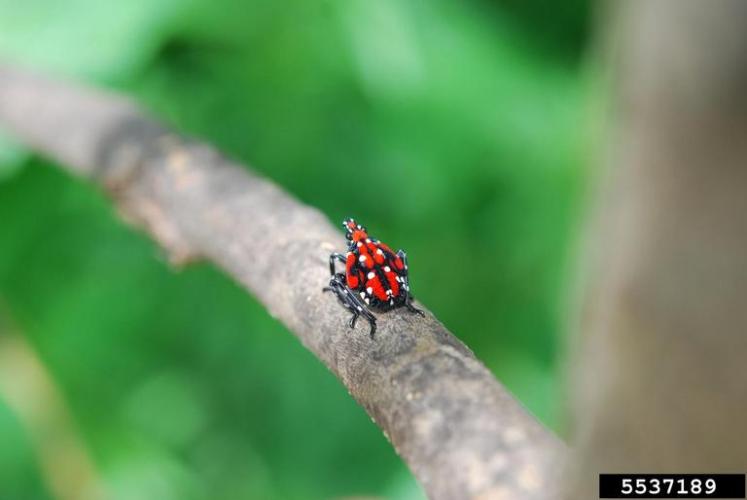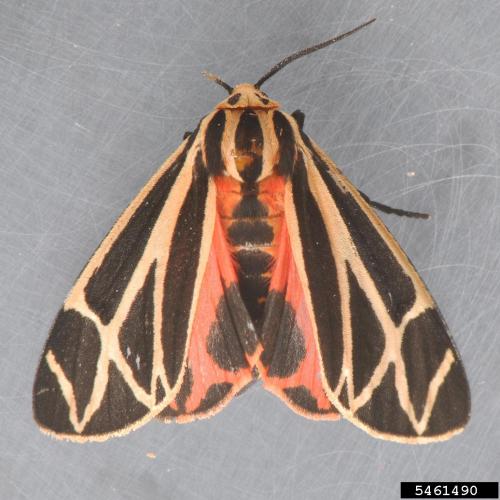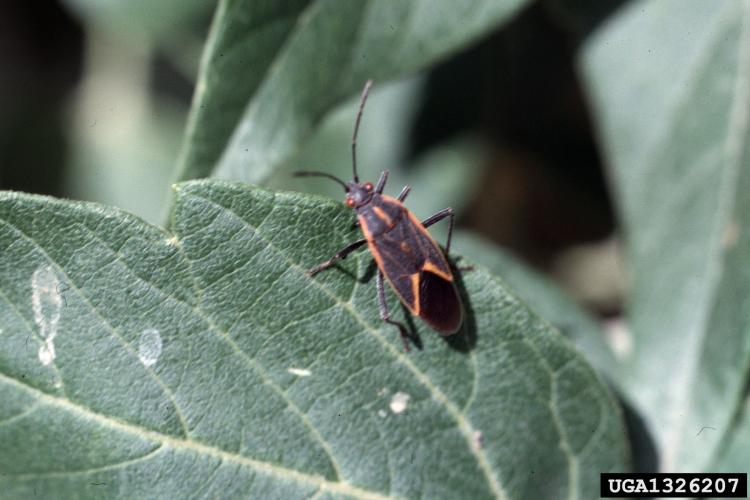Spotted Lanternfly
Identification
The spotted lanternfly adult is about one inch long and half an inch wide. The abdomen is yellow with black bars running across. It is the color and pattern of the wings that give it its name. The forewing is gray and speckled black at the base and black with gray cross veins near the tips. The hind wings feature a bright red base, a white stripe in the middle and a black tip. Young nymphs are black with white spots. The fourth nymphal instar turns red and black before maturing. This invasive bug is not yet known to have established a breeding population in Vermont.
signs and symptoms
- Weeping wounds on trees (such as Tree-of-Heaven)
- Greyish or black trails of sap on trunk from wounds
- Wasps and ants attracted to sap from sounds
- Egg masses in late fall on host trees and nearby smooth surfaces like stone, outdoor furniture, vehicles, and structures.
- Newly laid egg masses have a grey mud-like covering which can take on a dry cracked appearance over time
- Old egg masses appear as rows of 30-50 brownish seed-like deposits in 4-7 columns on the trunk, roughly an inch long.
See image slideshow above for signs and symptoms. View factsheet from Department of Environmental Conservation with common spotted lanternfly look-alikes.
Biology
Origin
The Spotted Lanternfly was first discovered in the United States in Pennsylvania in 2014. It is originally from China and South Asian countries such as India. It was discovered in Pennsylvania in the fall of 2014 and has the potential to become a serious agricultural pest without natural pests and predators keep populations low. It was accidentally introduced into South Korea in 2006 and has spread dramatically, making it a major agricultural pest, especially for grape production. At first, the risk of spread in the northern US was believed to be lower due to cold Pennsylvania winters, but it has now been discovered that many eggs and newly hatched nymphs have survived the winter.
Life Cycle
In the fall adults congregate in large groups on tree trunks, especially of tree of heaven. Females begin to lay eggs in late September on trunks, branches, stones, and many other smooth surfaces. The egg masses typically contain 30-50 eggs and are usually about an inch long. The egg masses are gray and covered with a material that first appears waxy, like wet mud and then dries and cracks. The insect overwinters in the egg mass. Nymphs hatch out in the spring and begin to mature in early summer.
ecological threat
The spotted lanternfly is a sap-feeding planthopper. Nymphs and adults feed on sap from stems and leaves. Both life stages have been found on apples, plums, cherries, peaches, nectarines, apricots, almonds, grapes as well as forest trees like maples, oak, pine, walnut, poplar willow and sycamore. When it is present, adults prefer tree of heaven (Ailanthus altissima), which is also an invasive species. Damage is done in two ways. Removing sap reduces photosynthesis, weakening the plant. Host plants are also damaged indirectly as the adults excrete honeydew which allows the growth of sooty mold fungus on the leaves, stems, and fruit. This growth further reduces photosynthesis and attracts ants, flies, wasps, and bees.
Vermont Distribution
Spotted lanternfly was first discovered in Berks County, Pennsylvania in September of 2014. It is thought to have arrived on a stone shipment around 2012. It has since spread to 26 counties in Pennsylvania and is under a quarantine in that state.
Since then, spotted lanternfly infestations have also been found in several states, including Connecticut, Delaware, Maryland, New Jersey, New York, Virginia, and West Virginia and Ohio (view a map).
In August 2021, three adult spotted lanternflies were intercepted (in Vermont) in a tractor trailer originating from a state with documented infestations of the invasive pest. The three pests were killed. There is no indication the pest is established in Vermont. Massachusetts has had a number of similar interceptions of individual live and dead insects. Additionally, egg masses have been found on trees in Maine. These events are a reminder that it is important to be on the lookout for this invasive insect to prevent it becoming established in Vermont.
How You Can Help
1. Stop the spread of this insect by using this checklist. If you’ve spent any time in an area infested with Spotted Lanternfly it is important to check for egg masses, adults, and nymphs on your vehicle and, when applicable, any items you may be transporting listed on this page.
2. Found SLF? Report it! If you think you found spotted lanternfly egg mass or insect, please report it!
Citations
photo credit
SLF, Kenneth R. Law, USDA APHIS PPQ, Bugwood.org
SLF, Lawrence Barringer, Pennsylvania Department of Agriculture, Bugwood.org
Tiger moth, Mark Dreiling, Bugwood.org
Boxelder beetle, Whitney Cranshaw, Colorado State University, Bugwood.org
